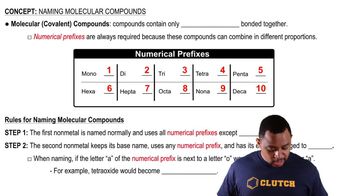Here are the essential concepts you must grasp in order to answer the question correctly.
Oxidation States
Oxidation states, or oxidation numbers, are a way to keep track of electrons in chemical compounds. They indicate the degree of oxidation of an atom in a substance, helping to determine how electrons are transferred in redox reactions. The oxidation state of an element in a compound can be positive, negative, or zero, depending on its electron gain or loss relative to its elemental form.
Recommended video:
Naming Compounds
Naming compounds involves using systematic rules to assign names based on their chemical composition. For ionic compounds, the cation (positive ion) is named first, followed by the anion (negative ion). In the case of polyatomic ions, such as chlorate in KClO₃, specific naming conventions apply, which are essential for accurately identifying the compound.
Recommended video:
Naming Molecular Compounds
Polyatomic Ions
Polyatomic ions are ions composed of two or more atoms covalently bonded, which carry a net charge. Common examples include sulfate (SO₄²⁻) and nitrate (NO₃⁻). Understanding polyatomic ions is crucial for naming compounds and determining oxidation states, as they often influence the overall charge and structure of the compound.
Recommended video:
Polyatomic Ion Variations

 Verified step by step guidance
Verified step by step guidance

